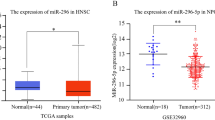Abstract
To explore the effects of RNA interference targeting four different genes (VEGF, C-myc, Survivin, hTERT) on the growth and proliferation of nasopharyngeal carcinoma (NPC) CNE-2Z cells. Fluorescein-labeled short-hairpin (sh)RNA plasmids together and separately targeting VEGF, C-myc, Survivin and hTERT were built and respectively called plasmid-shVEGF-shC-myc-shSurvivin-shhTERT, plasmid-shVEGF, plasmid-shC-myc, plasmid-shSurvivin, plasmid-shhTERT. These plasmids were respectively transfected into human NPC CNE-2Z cells and xenograft tumors in nude mice. The expression of plasmids in NPC CNE-2Z cells and xenograft tumors was observed. Cell proliferation was detected with MTT assay. The mRNA and protein expression were determined by real-time PCR and western blot, respectively. The effects of plasmids on the biological behavior of CNE-2Z cells were observed with transwell invision chamber models. Apoptosis was determined with flow cytometer. The inhibitory effect of plasmids on xenograft tumors was observed in nude mice. The plasmid containing four different shRNAs could significantly inhibit CNE-2Z cell proliferation and decrease invasion ability in vitro compared with plasmids with each single shRNA (P<0.05). The plasmid containing four different shRNAs could simultaneously downregulate VEGF, C-myc, surviving, hTERT mRNA and protein expression in the CNE-2Z cells. The multiple gene shRNA could more significantly induce cell apoptosis than each single shRNA, respectively (P<0.05). The combinative silencing of these four genes had a better inhibitory effect on xenograft tumors than the silencing of each single shRNA (P<0.05). RNA interference targeting multiple genes can effectively inhibit NPC proliferation and induce apoptosis, which provides an experiment basis for NPC gene therapy.
This is a preview of subscription content, access via your institution
Access options
Subscribe to this journal
Receive 12 print issues and online access
$259.00 per year
only $21.58 per issue
Buy this article
- Purchase on Springer Link
- Instant access to full article PDF
Prices may be subject to local taxes which are calculated during checkout





Similar content being viewed by others
References
Geara FB, Glisson BS, Sanguineti G, Tucker SL, Garden AS, Ang KK et al. Induction chemotherapy followed by radiotherapy versus radiotherapy alone in patients with advanced nasopharyngeal carcinoma: results of a matched cohort study. Cancer 1997; 79: 1279–1286.
Reich SJ, Fosnot J, Kuroki A, Tang W, Yang X, Maguire AM et al. Small interfering RNA (siRNA) targeting VEGF effectively inhibits ocular neovascularization in a mouse model. Mol Vis 2003; 9: 210–216.
Chen Z, Koeneman KS, Corey DR . Consequences of telomerase inhibition and combination treatments for the proliferation of cancer cells. Cancer Res 2003; 63: 5917–5925.
Su J, Richter K, Zhang C, Gu Q, Li L . Differential regulation of interleukin-1 receptor associated kinase-1 (IRA K 1) splice variants. Mol Immunol 2007; 44: 900–905.
Sharp PA . RNA interference-2001. Genes Dev 2001; 15: 485–490.
Leung RK, Whittaker PA . RNA interference: from gene silencing to gene-specific therapeutics. Pharmacol Ther 2005; 107: 222–239.
Gartel AL, Kandel ES . RNA interference in cancer. Biomol Eng 2006; 23: 17–34.
Arora S, Kaur J, Sharma C, Mathur M, Bahadur S, Shukla NK et al. Stromelysin 3, Ets-1, and vascular endothelial growth factor expression in oral precancerous and cancerous lesions: correlation with microvessel density, progression, and prognosis. Clin Cancer Res 2005; 11: 2272–2284.
Kwak N, Okamoto N, Wood JM, Campochiaro PA . VEGF is major stimulator in model of choroidal neovascularization. Invest Ophthalmol Vis Sci 2000; 41: 3158–3164.
Terasawa K, Sagae S, Takeda T, Ishioka S, Kobayashi K, Kudo R . Telomerase activity in malignant ovarian tumors with deregulation of cell cycle regulatory proteins. Cancer Lett 1999; 142: 207–217.
Lichner Z, Silhavy D, Burgyan J . Double-stranded RNA-binding proteins could suppress RNA interference-mediated antiviral defences. J Gen Virol 2003; 84: 975–980.
Altieri DC . Validating survivin as a cancer therapeutic target. Nat Rev Cancer 2003; 3: 46–54.
Tamm I, Wang Y, Sausville E, Scudiero DA, Vigna N, Ottersdorf T . IAP-family protein surviving inhibits caspases activity and apoptosis induced by Fas (CD95), Bax, caspases, and anticancer drugs. Cancer Res 1998; 58: 5315–5320.
Xiang H, Wang J, Mao YW, Li DW . hTERT can function with rabbit telomerase RNA: regulation of gene expression and attenuation of apoptosis. Biochem Biophys Res Commu 2000; 278: 503–510.
Liu Y, Snow BE, Hande MP, Yeung D, Erdmann NJ, Wakeham A et al. The telomerase reverse transcriptase is limiting and necessary for telomerase function in vivo. Curr Biol 2000; 10: 1459–1462.
Shay JW, Bacchetti S . A survey of telomerase activity in human cancer. Eur J Cancer 1997; 33: 787–791.
Hahn WC, Stewart SA, Brooks MW, York SG, Eaton E, Kurachi A et al. Inhibition of telomerase limits the growth of human cancer cells. Nat Med 1999; 5: 1164–1170.
Hwang CF, Su CY, Kou SC, Huang SC, Leung SW, Huang CM et al. Diagnostic usefulness of telomerase activity in nasopharyngeal carcinoma. Jpn J Cancer Res 2000; 91: 760–766.
Fire A, Xu S, Montgomery MK, Kostas SA, Driver SE, Mello CC . Potent and specific genetic interference by double-stranded RNA in Caenorhabditis elegans. Nature 1998; 391: 806–811.
Ter Brake O, Konstantinova P, Ceylan M, Berkhout B . Silencing of HIV-1 with RNA interference: a multiple shRNA approach. Mol Ther 2006; 14: 883–892.
Wang Y, Tao ZZ, Chen SM, Xiao BK, Zhou XH, Liu JP . Application of combination of short hairpin RNA segments for silencing VEGF, TERT and Bcl-xl expression in laryngeal squamous carcinoma. Cancer Biol Ther 2008; 7: 896–901.
Author information
Authors and Affiliations
Corresponding author
Ethics declarations
Competing interests
The authors declare no conflict of interest.
Rights and permissions
About this article
Cite this article
Song, Y., Dong, MM. & Yang, Hf. Effects of RNA interference targeting four different genes on the growth and proliferation of nasopharyngeal carcinoma CNE-2Z cells. Cancer Gene Ther 18, 297–304 (2011). https://doi.org/10.1038/cgt.2010.80
Received:
Revised:
Accepted:
Published:
Issue Date:
DOI: https://doi.org/10.1038/cgt.2010.80



